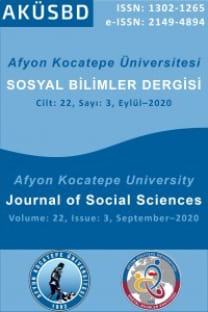Structural Changes and Purchasing Power Parity in Turkish Exchange Rates
PPP hypothesis, Structural shifts, Turkey
Structural Changes and Purchasing Power Parity in Turkish Exchange Rates
___
- Adigüzel, U, Şahbaz, A., Özcan, C. C. and Nazlioğlu, Ş. (2014). “The Behavior of Turkish Exchange Rates: A Panel Data Perspective”, Economic Modelling, 42, pp. 117-185.
- Bahmani-Oskooee, M., Chang, T., Liu W. C. (2014). “Revisiting Purchasing Power Parity in 34 OECD Countries: Sequential Panel Selection Method”, Applied Economics Letters 21(18), pp.1283-1287.
- Becker, R., Enders, W. and Lee, J. (2006). “A Stationarity Test in The Presence of an Unknown Number of Smooth Breaks”, Journal of Time Series Analysis 27, pp. 381–409.
- Carrion-I-Silvestre, J. L. and Sansó, A. (2007). “The KPSS Test with Two Structural Breaks”, Spanish Economic Review 9(2), pp. 105-127.
- Dickey, D. A. and Fuller, W. A. (1981). “Likelihood Ratio Statistics for Autoregressive Time Series with a Unit Root”, Econometrica, 49, pp. 1057-1072.
- Enders, W. and Lee, J. (2012). “The Flexible Fourier Form and Dickey-Fuller Type Unit Root Tests”, Economics Letters 117, pp. 196-199.
- Karagöz, K. ve Saraç, B. (2016). “Testing the Validity of PPP Theory for Turkey: Nonlinear Unit Root Testing”, Procedia Economics and Finance 38, pp. 458 – 467.
- Kurozumi, E. (2002). “Testing for Stationarity with a Break”, Journal of Econometrics 108(1), pp. 63-99.
- Kwiatkowski, D., Phillips, P. C.B., Schmidt, P. and Shin, Y. (1992). “Testing the Null Hypothesis of Stationary against the Alternative of a Unit Root”, Journal of Econometrics 54, pp. 159–178.
- Lee, J., Huang, C. J. and Shin, Y. (1997). “On Stationary Tests in the Presence of Structural Breaks”, Economics Letters 55, pp. 165-172.
- Narayan, P. K. and POPP, S. (2010). “A New Unit Root Test with Two Structural Breaks in Level and Slope at Unknown Time”, Journal of Applied Statistics 37(9), pp. 1425-1438.
- Perron, P. (1989). “The Great Crash, the Oil Price Shock, and the Unit Root Hypothesis”, Econometrica 57, pp. 1361-1401.
- Sul, D., Phillips, P. and Choi, C. (2005). “Prewhitening Bias in HAC Estimation”, Oxford Bulletin of Economics and Statistics 67(4), pp. 517-546.
- Zivot, E. and Andrews, D.W.K. (1992). “Further Evidence on the Great Crash, the Oil-Price Shock, and the Unit-Root Hypothesis”, Journal of Business & Economics- Statistics 10, pp. 251-270.
- ISSN: 1302-1265
- Yayın Aralığı: 4
- Başlangıç: 1999
- Yayıncı: Afyon Kocatepe Üniversitesi Sosyal Bilimler Enstitüsü
Batı Akdeniz Yörüklerinin Ağzında Eski Türkçe Unsurlar
16-18. Yüzyılda Osmanlı Doğu Vilayetlerinde Safevi/Acem Hacılarıyla İlgili Değerlendirmeler
İbrahim KILIÇ, Hürriyet ÇİMEN, Tülin TUNÇ, Neslihan KAN SÖNMEZ
İşgörenlerin Örgütsel Güven Algılarının Belirlenmesi: Üniversite Çalışanları Üzerinde Bir İnceleme
Temsili Demokrasideki Siyasal Katılım Sorununun Çözümünde Türkiye ve AB’nin STK’lara Yaklaşımı
Duygusal Emek Kişilik Özellikleri ile İlişkili mi? Otel Çalışanları Üzerine Bir Araştırma
Türk Basınında Suriyeli Göçmenlere İlişkin Haberlere Yapılan Yorumların İncelenmesi
Türk Bankacılık Sektörünün Aktif Yapısındaki Değişim Ve Gelişimler
Cantürk KAYAHAN, Hakan SARIKALE
Anna Seghers’in Yedinci Şafak adlı Romanında Toplama Kampı ve Şiddet Olgusu
